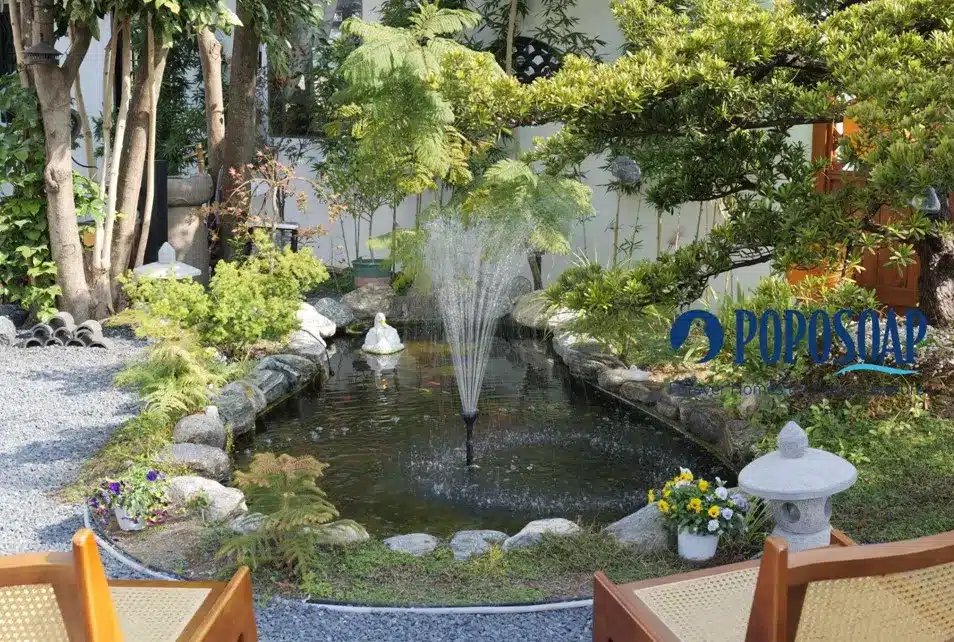After months of winter, your pond may be clouded with debris, leaves, and waste, making it look uninviting and potentially harmful to its ecosystem. If not cleaned properly, these accumulated materials can affect the overall health of your pond and its ecosystem.
Spring is the perfect time to clean your pond, helping it return to its natural beauty and providing a fresh, healthy environment for your fish and plants. A professional pond cleaning will ensure that your pond thrives all season long, with clear water and a balanced ecosystem.
Why Professional Pond Cleaning Matters
Over winter, your pond goes through a lot. Decomposing leaves, fish waste, dead plants, and stagnant water all contribute to sludge buildup. If not cleaned properly, this debris can lead to:
- Algae blooms
- Poor water quality
- Foul odors
- Increased fish diseases
- Ugly, cloudy water
A thorough, professional-grade cleaning restores your pond’s balance and ensures a healthy environment for fish, plants, and beneficial bacteria.
When Is the Best Time to Clean Your Pond?
Spring is the perfect time to deep-clean your pond because:
- Water temperatures are rising (ideally between 50–65°F)
- Aquatic plants are just beginning to grow
- Fish are coming out of their winter dormancy
- It’s easier to reset the ecosystem before the full heat of summer
Aim to start your cleaning routine early, usually between late March and mid-May, depending on your local climate.
Step-by-Step Guide to Professionally Clean Your Pond
Ready to get your pond sparkling? Here’s how to tackle the process like a pro:
1. Gather the Right Tools
Before you start, assemble everything you’ll need:
- Pond vacuum or sludge pump
- Fish-safe holding tank or kiddie pool
- Fine mesh net
- Skimmer net
- Buckets
- Pressure washer (optional)
- Dechlorinated water for refilling
- Bacteria starter
- Protective gloves
Having the right tools will make the job faster, safer, and more efficient, including using a Poposoap solar fountain pump to ensure continuous water movement after cleaning
2. Remove Fish and Plants Safely
Your fish and plants are delicate, so start by:
- Filling a holding tank with pond water
- Gently catching fish using a soft, wide net
- Placing aquatic plants in buckets of pond water
Keep the holding tank shaded and aerated if possible. Try to limit fish holding time to just a few hours.
3. Drain the Pond
Using a pump or siphon hose, drain your pond completely. Capture and save some of the pond water in buckets to use when reintroducing fish later. This helps minimize shock by maintaining familiar water chemistry.
4. Remove Debris and Sludge
Once the pond is drained:
- Scoop out leaves, sticks, and dead organic matter
- Remove any excess sludge or muck from the bottom
- Clean rocks, gravel, and pond liner surfaces
For thick muck, a pond vacuum or shop vac works wonders. Removing this buildup is key to preventing nutrient overload that can fuel algae growth.
5. Clean Water Features
If you have waterfalls, streams, or fountains, give them a good scrub too. Buildup in water features can harbor harmful bacteria and algae spores.
- Use a soft brush and water (avoid soaps or chemicals)
- Check for clogs or blockages
- Rinse thoroughly with pond water
6. Rinse and Inspect
Lightly pressure-wash pond walls and features to remove stubborn grime. Be careful not to damage the pond liner.
This is also the ideal time to inspect for:
- Tears or leaks in liners
- Broken pumps or filters
- Worn-out plumbing
Fix any problems now before refilling the pond.
7. Refill the Pond
Refill the pond with clean water, ideally dechlorinated to protect fish and plants. If you must use city tap water, treat it with a dechlorinator product first.
Allow the pond to sit for a few hours to stabilize temperature and pH levels before adding fish back in.
8. Reintroduce Fish and Plants
Gradually acclimate your fish to the new water:
- Float fish bags or buckets in the pond for 15–30 minutes
- Slowly add pond water to their container
- Release the fish gently into the pond
Reposition aquatic plants, trimming dead leaves if necessary.
9. Jumpstart the Ecosystem
To reestablish beneficial bacteria that help balance your pond:
- Add a biological starter or beneficial bacteria product
- Ensure proper filtration and aeration
- Monitor water parameters (ammonia, nitrite, pH)
Balanced bacteria will help break down waste naturally and keep your pond sparkling longer.
10. Install or Upgrade Water Circulation Systems
One of the best ways to maintain clear water after cleaning is to ensure excellent circulation. Water movement discourages stagnation, discourages algae, and improves oxygenation for fish.
Eco-conscious homeowners often turn to Poposoap solar water pump These solar-powered pumps:
- Circulate water without electricity
- Reduce algae blooms
- Promote healthier fish and plants
- They are easy to install and maintain
Using a Poposoap solar water pump after cleaning can keep your pond fresh with minimal environmental impact.
Bonus Tips for Maintaining a Crystal-Clear Pond After Cleaning
Cleaning your pond professionally in spring is just the first step. Here’s how to keep it pristine all season long:
Regular Skimming
Skim leaves and debris from the surface at least once a week. A pond skimmer net or automatic skimmer can save you time and effort.
Plant Wisely
Add submerged and marginal plants like water lilies, lotus, and hornwort. These plants:
- Absorb excess nutrients
- Provide shade that limits algae
- Offer shelter for fish
A balanced plant-to-water ratio can naturally keep your pond cleaner.
Watch Feeding
Overfeeding fish leads to uneaten food and excess waste, which can foul the water. Feed your fish sparingly, and only what they can consume in a few minutes.
Monitor Water Chemistry
Use a pond test kit regularly to monitor:
- Ammonia levels
- Nitrites and nitrates
- pH
- Oxygen levels
Balanced water chemistry prevents most pond problems before they start.
Add a UV Clarifier
For persistent green water issues caused by algae, consider installing a UV clarifier. It safely zaps algae spores without harming fish or plants.
Perform Partial Water Changes
Changing 10–20% of your pond water monthly helps dilute toxins and replenish minerals. Always use dechlorinated water if you’re on city supply.
Keep Water Moving
Finally, don’t forget to maintain water movement. Whether through waterfalls, fountains, or reliable options like Poposoap solar water pumps, moving water stays healthier and cleaner.
Solar water pumps are particularly advantageous because:
- They operate independently of your home’s power supply
- They’re energy-efficient and eco-friendly
- They reduce your utility costs
Adding this simple device can make a huge difference in water quality and clarity.
Wrapping up: Spring pond cleaning
Spring pond cleaning isn’t just a chore, it’s an opportunity to renew your pond’s beauty and health for the entire year. By following a professional approach, removing sludge, protecting your fish, and jumpstarting your ecosystem, you set the stage for sparkling, thriving water.
Don’t forget: Maintaining clear water requires consistent attention, smart planting, careful feeding, and good circulation. Eco-friendly solutions like Poposoap solar water pumps offer a simple, sustainable way to keep your pond fresh, oxygenated, and beautiful without raising your electricity bill.
Also Read-Selecting the Right Tech Stack for Mobile App Success










